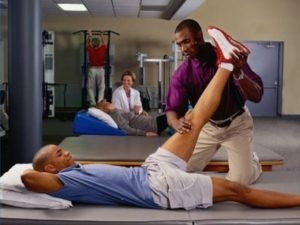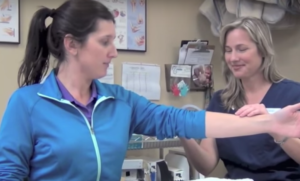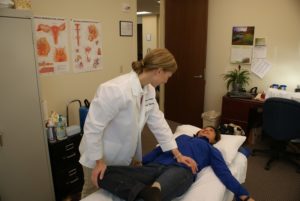Managing and Treating Tendonitis
 Tendonitis (also referred to as tendinitis) occurs when the tendon, a thick cord of tissue that connects bones to muscles, becomes irritated or inflamed. This occurs when the load placed on the tendon is consistently more than the tendon can take. Although anyone can get tendonitis, it is most common among adults – especially those aged 40 or older whose tendons have lost elasticity or extremely active adults who may overdo it from time to time. Tendonitis is also sometimes referred to colloquially as “golfer’s elbow,” “swimmer’s shoulder,” and “jumper’s knee.”
Tendonitis (also referred to as tendinitis) occurs when the tendon, a thick cord of tissue that connects bones to muscles, becomes irritated or inflamed. This occurs when the load placed on the tendon is consistently more than the tendon can take. Although anyone can get tendonitis, it is most common among adults – especially those aged 40 or older whose tendons have lost elasticity or extremely active adults who may overdo it from time to time. Tendonitis is also sometimes referred to colloquially as “golfer’s elbow,” “swimmer’s shoulder,” and “jumper’s knee.”
There are a number of activities and conditions that can provoke the onset of tendonitis. These may include:
- Poor walking form and habits
- Sports that involve repetitive movements like tennis, golf, skiing or throwing and pitching
- Stress on soft tissues caused by, such as leg length differences or deformities of the joint
- Certain types of arthritis or related conditions like gout
- Diabetes or other metabolic conditions
- Medication side-effects, although this is rare
Unfortunately, the condition can be very painful and in some cases debilitating. The Bureau of Labor Statistics estimates that tendonitis causes 70,000 people to miss work each year. A study published in Clinical Orthopedic Surgery found that, among people with confirmed job-related tendonitis, the most common occupations as sources of injury were construction and extraction occupations (44.2%), food preparation or serving-related jobs (14.4%) and transportation and material moving jobs (12.5%).
Common areas of the body affected by tendonitis include:
- Base of the thumb
- Shoulder
- Elbow
- Hip
- Achilles tendon
- Knee
Symptoms of Tendonitis
Tendonitis is characterized by inflammation, tenderness and pain in areas around a joint, including the tendons, ligaments and muscles. Swelling may also occur in the affected area, as well as redness and in some cases a lump along the tendon.
Certain types of tendonitis can occur suddenly, persist for days but get better with rest.
Treatment for Tendonitis
 Initially, providers recommend that tendonitis be treated with the “RICE” method, which stands for:
Initially, providers recommend that tendonitis be treated with the “RICE” method, which stands for:
- Rest – Rest is the most effective way for the inflammation in the affected area to cede. A bandage, splint or brace could be helpful to restrict movement.
- Ice – It is important to note that ice should not be applied directly to the skin, but rather it should be wrapped in a towel.
- Compression – Compressing the tendon can help to preserve mobility in a joint.
- Elevation – Raising the affected area to a level above the heart can reduce swelling and preserve mobility. This is especially helpful for knee-based tendonitis.
Patients can also consider taking anti-inflammatory over-the-counter drugs like ibuprofen to help manage pain and swelling.
If none of these methods bring relief, patients should consider visiting a physical therapist for more specialized tendonitis treatment and further injury prevention. Should discomfort last, surgery may be required as a last effort to relieve pain, but this is relatively rare for tendonitis.
The Role of Physical Therapy in Tendonitis Recovery
 The nature of the injury indicates that it can become a chronic condition that not only affects athletic performance or ability to exercise, but also everyday mobility. Studies have shown that physical therapy for all forms of tendonitis can help to reduce pain and strengthen the muscles around the damaged tendon to help avoid similar injuries in the future.
The nature of the injury indicates that it can become a chronic condition that not only affects athletic performance or ability to exercise, but also everyday mobility. Studies have shown that physical therapy for all forms of tendonitis can help to reduce pain and strengthen the muscles around the damaged tendon to help avoid similar injuries in the future.
Physical therapists can administer many types of treatment to help provide relief for patients with tendonitis, including:
- Hot and cold therapy
- Ultrasound therapy
- Laser therapy
- Water therapy
- Soft tissue or joint mobilization
- Orthotics or pressure-relieving devices
- Personalized exercise programs
- Posture and walking analysis
- Education about appropriate activities
Beyond pain relief, manual therapy performed by a physical therapist for tendonitis can produce promising results, including but not limited to:
- Improved function
- Movement facilitation
- Relaxation inducement
- Reduction or even elimination of soft tissue inflammation
- Increase in flexibility and mobility
- Improvement of tissue repair/extensibility/stability
With physical therapy patients can expect recovery to take between weeks and months depending on the severity of the case.
